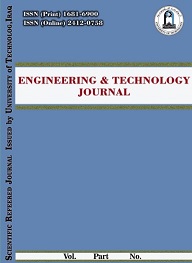Abstract
This study investigated the thermal performance of the heat pipe and conducted on the effects of working fluids with wick and vertical position. The experiments were conducted using a copper heat pipe with ( a 20.8 ) mm inner diameter, and
the length of the evaporator, the condenser, and the adiabatic regions were 300
mm, 350 mm, and 300 mm, respectively. The working fluids selected were
water, Methanol, Ethanol, and different binary mixtures (50: 50)%, (30:70)%,
and (70:30)% mixing ratios. The filling ratio for all working fluids remained
constant with the value of 50% of the evaporator volume, and the heat input
values were 20, 30, 40, and 50 watts. The results show that the heat pipe charged
with Methanol has a thermal resistance of (0.7666oC/W) which is the lowest
value of thermal resistance. The lowest thermal resistance of using mixtures is
(0.7466℃/W) for (70% methanol: 30% ethanol). Both are achieved at 50 W heat
input. Also, the highest value of heat transfer coefficient when using water as a
working fluid is (519.1073 W/m2.oC), and for using a mixture (70% water: 30%
methanol) is (805.89 W/m2.oC). Both are achieved at 50 W heat input.
the length of the evaporator, the condenser, and the adiabatic regions were 300
mm, 350 mm, and 300 mm, respectively. The working fluids selected were
water, Methanol, Ethanol, and different binary mixtures (50: 50)%, (30:70)%,
and (70:30)% mixing ratios. The filling ratio for all working fluids remained
constant with the value of 50% of the evaporator volume, and the heat input
values were 20, 30, 40, and 50 watts. The results show that the heat pipe charged
with Methanol has a thermal resistance of (0.7666oC/W) which is the lowest
value of thermal resistance. The lowest thermal resistance of using mixtures is
(0.7466℃/W) for (70% methanol: 30% ethanol). Both are achieved at 50 W heat
input. Also, the highest value of heat transfer coefficient when using water as a
working fluid is (519.1073 W/m2.oC), and for using a mixture (70% water: 30%
methanol) is (805.89 W/m2.oC). Both are achieved at 50 W heat input.
